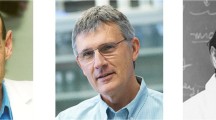Abstract
The ras oncogenes are implicated in the onset of some human tumours, and in cellular proliferation and terminal differentiation. The ras proteins are plasma membrane bound transducers of signals between the outside of the cell and unknown targets in the cell1,2. Identifying these targets and understanding how they are regulated will have a major impact on our understanding of the molecular basis of transformation. We have already shown that c-Ha-ras and the tumor promoter TPA (12-o-tetradecanoyl phor-bol-13-acetate) can activate a transcriptional enhancer3. We now report the identification of a short sequence in the polyoma virus (Py) enhancer which mediates Ha-ras activation, and show that this sequence (ras responsive element, RRE) also mediates activation by TPA and serum. This responsive element is a specific binding-site for the mouse transcription factor PEA1 (ref. 4 and below) and for the jun oncogene (ref. 5 and M. Karin, personal communication). These results are in keeping with a role for ras protein in signal transduction from outside the cell to a transcription factor in the nucleus, through protein kinase C1,2. The striking similarity between RRE and DNA sequences present in the promoter regions of a number of transformation-related genes suggests that deregulated activation of RRE is a critical event in transformation.
Similar content being viewed by others
References
Barbacid, M. A. Rev. Biochem. 56, 779–827 (1987).
Micheal, R. & Jackson, T. Nature 328, 668–669 (1987).
Wasylyk, C., Imler, J. L., Perez-Mutul, J. & Wasylyk, B. Cell 48, 525–534 (1987).
Piette, J. & Yaniv, M. EMBO J. 6, 1331–1337 (1987).
Bohmann, D. et al. Science 238, 1386–1392 (1987).
Zenke, M. et al. EMBO, J. 5, 387–397 (1986).
Lacal, J. C., Fleming, T. P., Warran, B. S., Blumberg, P. M. & Aaronson, S. A. Molec. cell. Biol. 7, 4146–4149 (1987).
Lacal, J. C., Moscat, J. & Aaronson, S. A. Nature 330, 269–272 (1987).
Angel, P. et al. Cell 49, 729–739 (1987).
Matrisian, L. M., Glaichenhaus, N., Gesnel, M. C. & Breathnach, R. EMBO J. 4, 1435–1440 (1985).
Lee, W., Mitchell, P. & Tjian, R. Cell 49, 741–752 (1987).
Struhl, K. Cell 50, 841–846 (1987).
Kryszke, M. H., Piette, J. & Yaniv, M. Nature 328, 254–256 (1987).
Veldman, G. M., Lupton, J. & Kamen, R. Molec. cell Biol. 5, 649–658 (1985).
Hassel, J. A., Muller, W. J. & Mueller, C. R. in Cancer Cells, vol. 4 (eds Botchan, M., Grodzickerl, T. & Sharp, P.) (Cold Spring Harbor Laboratory, New York, 1986).
Herbomel, P., Bourachot, B. & Yaniv, M. Cell 39, 653–662 (1984).
Wildeman, A. G. et al. Molec. cell. Biol. 6, 2098–2105 (1986).
Angel, P., Baumann, I., Stein, B., Delius, H., Rahmsdorf, H. J. & Herrlich, P. Molec. cell. Biol. 7, 2256–2266 (1987).
Fujita, T., Takaoka, C., Matsui, H. & Taniguchi, T. Proc. natn. Acad. Sci. U.S.A. 80, 7437–7441 (1983).
Author information
Authors and Affiliations
Rights and permissions
About this article
Cite this article
Imler, J., Schatz, C., Wasylyk, C. et al. A Harvey-ras responsive transcription element is also responsive to a tumour-promoter and to serum. Nature 332, 275–278 (1988). https://doi.org/10.1038/332275a0
Received:
Accepted:
Issue Date:
DOI: https://doi.org/10.1038/332275a0
- Springer Nature Limited
This article is cited by
-
ETS‐targeted therapy: can it substitute for MEK inhibitors?
Clinical and Translational Medicine (2017)
-
Comparison of MAPK specificity across the ETS transcription factor family identifies a high-affinity ERK interaction required for ERG function in prostate cells
Cell Communication and Signaling (2015)
-
Graded inhibition of oncogenic Ras-signaling by multivalent Ras-binding domains
Cell Communication and Signaling (2014)
-
Malolactomycin D, a potent inhibitor of transcription controlled by the Ras responsive element, inhibits Ras-mediated transformation activity with suppression of MMP-1 and MMP-9 in NIH3T3 cells
Oncogene (2001)
-
Attenuation of glucocorticoid receptor levels by the H-ras oncogene
Endocrine (1995)





